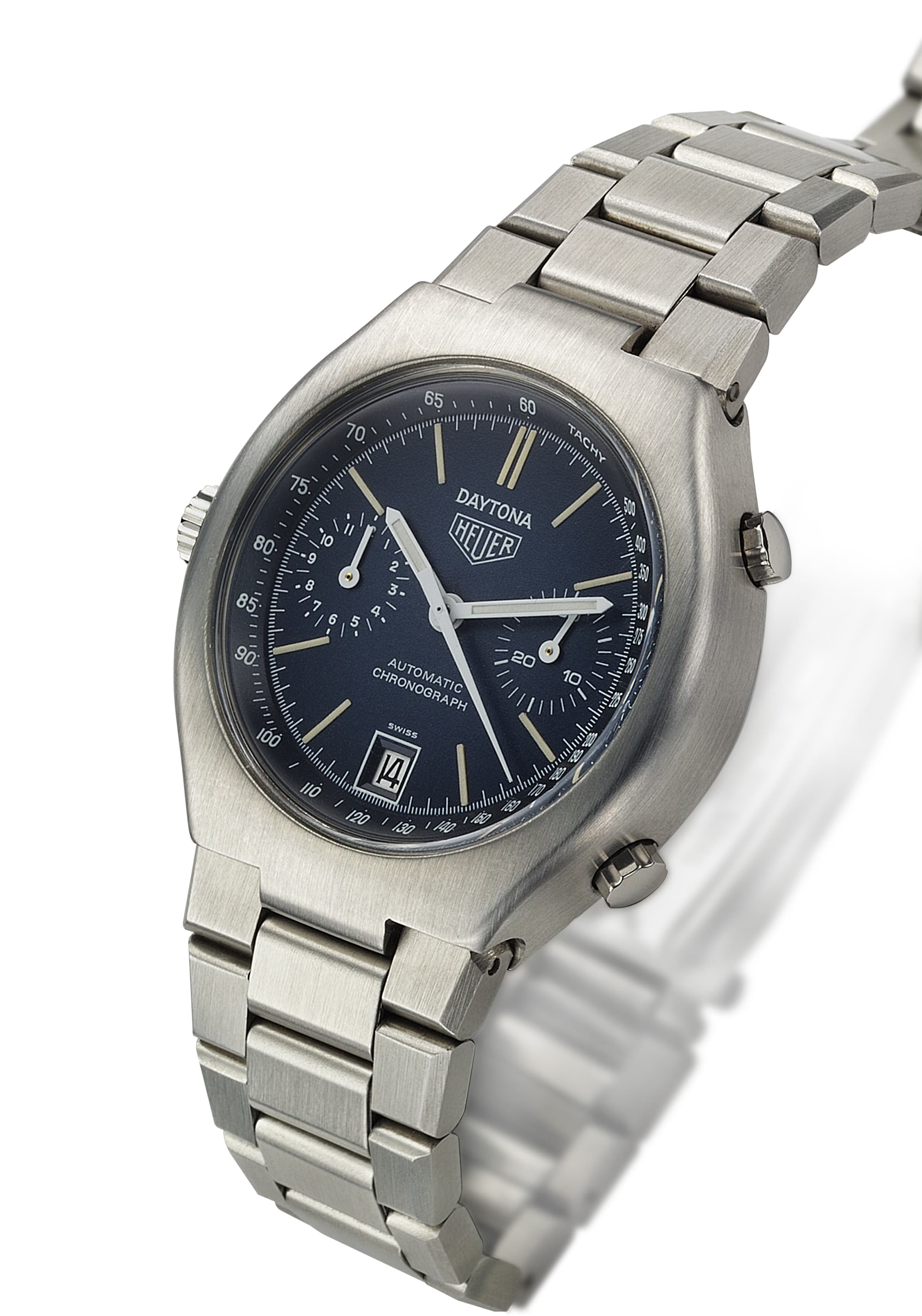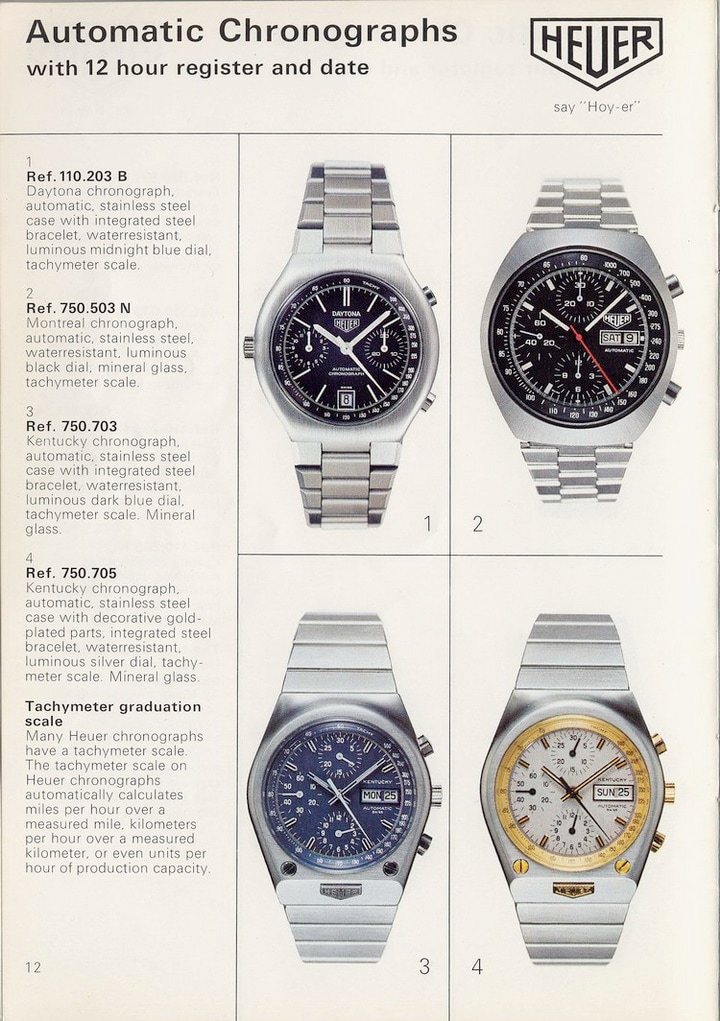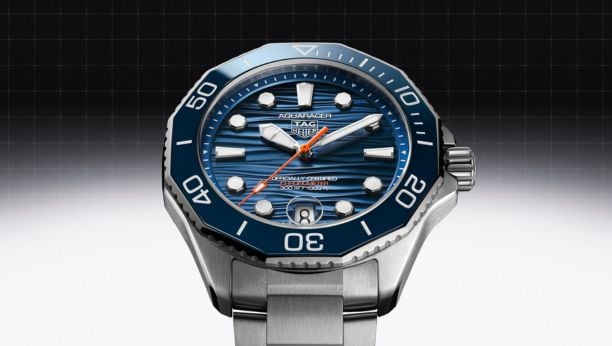VINTAGE COLLECTION
HEUER DAYTONA
Heuer introduced the electronic Chronosplit in 1975, and employed the same ultra-modern style case and integrated bracelet for the Daytona, with its automatic Calibre 12 movement. The “gradient” style of paint on both the midnight blue dial and fume models was prone to change over the years, with the result that for today’s collectors, no two samples will show exactly the same color. Each watch has a unique fingerprint, contributing to the mystery of collecting these models.
Heuer introduced its Calibre 12-powered chronographs in 1969, and these chronographs moved through three distinctive “generations” over the course of the 1970s. The “launch models” from 1969 – Autavia, and Carrera – grew out of the style of the 1960s, with the cases engineered to house the larger automatic movements and the Monaco represented the avant-garde design of the era. The “second generation” of automatic chronographs was launched in 1971, with Heuer creating bold styles of cases, dials and hands that would capture the adventure and outrageous look of the new decade. The Calculator, Montreal and Silverstone were oversized chunks of stainless steel that housed distinctive dials in blue, black, white, gold, red, blue and fume (smoke). With the “third generation”, introduced in 1976, Heuer dialed-back the excesses of the preceding 1970s models, incorporating the energy of racing and motorsports, but with a more refined, elegant look.
The Daytona chronograph, introduced in 1976 and named for one of the legendary racing venues, embodies Heuer’s approach in the third generation.

The design of the Daytona was a bold choice for the time. Jack Heuer, who was CEO of Heuer when the Daytona chronograph was launched, explained that he wanted to get away from the look of the Carrera and Monaco and offer something distinctly new. In fact, a close look at the case of the Daytona shows that its looks were inspired by a radical Heuer watch introduced just one year before: the Chronosplit.
BACKGROUND
Jack Heuer explains his choice of the name “Daytona”:
“Daytona was selected because it sounds good and is well known in our key market, the USA. We basically named many watches according to racetracks to show indirectly that we were really after the automotive sports public!”
In fact, the “Daytona” name was used regularly throughout the period, including the famous Ferrari 365GTB/4 that gained the nickname Daytona and the Rolex Daytona chronograph. The name comes from the Daytona International Speedway, at Daytona Beach, Florida. The track is the home of the famous Daytona 500 mile race for stock cars, as well as hosting an a 24-hour race for sports cars held on the combined oval and road track.
DESIGN
The Daytona offers a brushed 39mm stainless steel case (the same size as the contemporary Carrera), with the chronograph pushers on the right hand side and the crown on the left - the trademark calling card of the Calibre 12-powered Heuers.
One of the distinguishing features of the watch is the integrated steel bracelet, meaning that with the watch having no “lugs”, there are no leather strap options. The Daytona was not the only Heuer steel model with an integrated bracelet, with the watch sharing several elements of its design with the Heuer Cortina (below) that followed a year later in 1977. Both watches share a very similar dial (only the shape of the sub-dial hands differing), the same movement, similar case size and an integrated bracelet.
But where the Cortina was edgy and octagonal, the Daytona was rounded and soft, with a brushed steel finish and a plexi-crystal that fits flush to the case.
The Daytona chronograph adopted its “pebble” shape and case finish from the radical 1975 Heuer Chronosplit (below), albeit with the Daytona using a traditional mechanical movement, rather than the LED/ LCD movement of the Chronosplit. Both watches also have a steel bracelet that is designed to be an extension of the case.
The Heuer Daytona remained part of the Heuer range from 1976 through to 1980 when both the blue and the fume dial colours were discontinued. Despite the attractive looks, Jack Heuer remarks that the Daytona was “certainly not a flop, but not a major success either”. It suffered from the low-priced quartz competitors, just as with all mechanical watches in the late 1970s.

DIAL
The distinguishing feature of the Daytona’s dial is the subtle dégradé finish, meaning that the centre of the dial is a lighter colour that gradually becomes darker as you move towards the outer edge. There were two colour options; dark Blue and Fume (“Smoke”).
BRACELET
As mentioned above, the Daytona was only sold on a stainless steel bracelet, with the bracelet integrated into the “head” of the watch.
MOVEMENT
Powering the Daytona is Heuer’s own Calibre 12 Chronomatic movement, first launched as the Calibre 11 movement in the Monaco, Carrera and Autavia models in 1969. The movement sits behind a case back that also takes its inspiration from that offered on the Chronosplit, including the reference number and serial number being engraved on the caseback.
HEUER DAYTONA REF 110.203B – Blue Dial
The Blue Daytona is a relatively common model, with the beautiful “midnight blue” dial contrasting with the stainless steel case and hands. As with other vintage Heuer chronographs that used the deep blue dials (for example, the Monaco and the Skipper), the dials of the blue Daytona are prone undergo colour changes over the years, often becoming considerably lighter toward the center. Both the blue and the fume dial colours offer a black inner tachy flange, which frames the dial neatly.
HEUER DAYTONA REF 110.203F – Fume (Smoke) Dial
The fume model is less common that the blue and has a similar colour dial to the Silverstone, but without the starburst finish. The fume dials of the Daytona also show the effects of “patina”, with the pigment becoming lighter toward the center of the dial.







